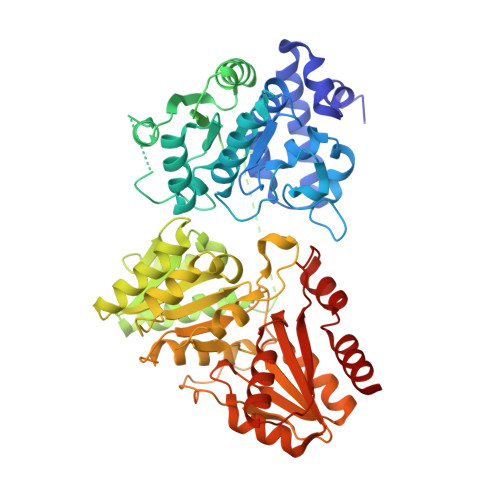Design of thiamine analogues for inhibition of thiamine diphosphate (ThDP)-dependent enzymes: Systematic investigation through Scaffold-Hopping and C2-Functionalisation.
Chan, A.H.Y., Ho, T.C.S., Irfan, R., Hamid, R.A.A., Rudge, E.S., Iqbal, A., Turner, A., Hirsch, A.K.H., Leeper, F.J.(2023) Bioorg Chem 138: 106602-106602
- PubMed: 37201323
- DOI: https://doi.org/10.1016/j.bioorg.2023.106602
- Primary Citation of Related Structures:
8BZX - PubMed Abstract:
Thiamine diphosphate (ThDP), the bioactive form of vitamin B 1 , is an essential coenzyme needed for processes of cellular metabolism in all organisms. ThDP-dependent enzymes all require ThDP as a coenzyme for catalytic activity, although individual enzymes vary significantly in substrate preferences and biochemical reactions. A popular way to study the role of these enzymes through chemical inhibition is to use thiamine/ThDP analogues, which typically feature a neutral aromatic ring in place of the positively charged thiazolium ring of ThDP. While ThDP analogues have aided work in understanding the structural and mechanistic aspects of the enzyme family, at least two key questions regarding the ligand design strategy remain unresolved: 1) which is the best aromatic ring? and 2) how can we achieve selectivity towards a given ThDP-dependent enzyme? In this work, we synthesise derivatives of these analogues covering all central aromatic rings used in the past decade and make a head-to-head comparison of all the compounds as inhibitors of several ThDP-dependent enzymes. Thus, we establish the relationship between the nature of the central ring and the inhibitory profile of these ThDP-competitive enzyme inhibitors. We also demonstrate that introducing a C2-substituent onto the central ring to explore the unique substrate-binding pocket can further improve both potency and selectivity.
- Yusuf Hamied Department of Chemistry, University of Cambridge, Lensfield Road, Cambridge CB2 1EW, UK.
Organizational Affiliation:


















